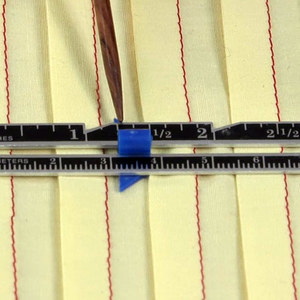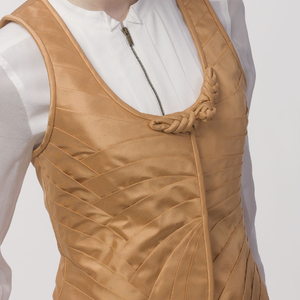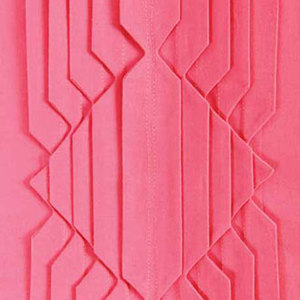
As seen in the upcoming season of the sewing television show It’s Sew Easy, Threads contributing editor Kenneth D. King shares his method for creating overlapping fabric tucks, also known as fluting. Watch as Kenneth explains how to strategically place folded bias-cut strips to form a stunning and complex surface design.
Follow along with the accompanying article, excerpted from “Curved Tucks” seen in Threads #166, and don’t forget to check out Kenneth’s step-by-step tutorial for creating the frog closure used on the vest.
What are you thoughts on fluting? Have you tried to create this couture technique? If so, share your experiences below!
































Very very nice
I have never found a bathing suit top that looks good and feels secure. For the longest time I've been trying to come up with a way to use a bra and overlay it with fashion fabric. I think this would be an ideal way to make the suit of my dreams, with water friendly fabrics, of course.
But what's a French Binding?
This looks a great technique- I have used bias folds in bridal bodices, but using a continuous piece of fabric - more of a draping approach I suppose. This will give a neater and more accurate result and the method is so straightforward with predictable results. Excellent! Can't wait to try it . Thanks Kenneth!
Hi there Kenneth,
I have so enjoyed watching your video this morning and absolutely adore the technique. I had wondered for a while how to do this, and now because of you sharing I know!!
I guess the pattern is your own design - classical and stylish, the perfect Kenneth D King combination.
Having seen skirts with what I thought were tucks and wondered how you would pattern draft them, this must be the answer.......................make the foundation of the skirt and then complete this method?
How I wished you would visit the UK and give us the opportunity of joining in with your classes.
It is so wonderful each time seeing your solutions to making garments! You are a really unique person! I love your way of making things just by finding out. You describe difficult looking techniques so well, so easy to understand. From the Netherlands, thank you Kenneth.
Hi,
Absolutely love Kenneth King's tutorials. I am wondering if the vest is also lined with silk using the princess line, and if there is a picture of that.
Thanks,
Harriet Heywood
love this idea, and you make it look so simple...thank you :-)
Thanks for the kind comments!
To answer questions:
To KWS1313: A French binding, is a bias binding used to finish neck edges and armholes. The beauty of this binding is that it's easier to manage than other bias bindings, and finishes to look the same on both sides.
It's a bias strip that is cut 6 times wider than the desired finished width, plus 1/4". So, if you want a 1/2" wide finished binding, you'll cut the strip 6 times 1/2"=3", plus 1/4", for 3 1/4" width of the bias strip. You'll press this strip in half, and sew it to the body of the piece, matching the raw edges. Sew at just shy of 1/2". The strip will fold up at the stitching line, then over the cut edges, where the folded edge will get slipstitched to the back of the work on the seam line.
To Smockerlady: I'd love to be invited to the UK!
This vest pattern is a princess line pattern from Vogue, I believe. The lining was a bridal satin, that was cut with the princess lines intact, as the foundation layer was. It needed a lining, as the stitching looks to ragged for my taste, to go unlined.
And you're correct in assuming that this technique can be used on any garment, just have a foundation layer behind where you want to put the curved tucks, so you have something to attach to.
To user2315379: I believe there is a photo in the article we did on Threads, showing the lining. The lining, though, was unremarkable--just bridal satin with the princess line sewn in.
To GalaxyGreeThings: Thanks for the compliment! My students at FIT loved this technique, as the method they learn there is rather more difficult, and to my eye, doesn't give as good a result. It really is simple, I don't make it look simple....
To Kiti63: I'd love to see this done in water-friendly fabrics, and I believe it will work. Generally you'd see this on the bust area, which generally has some supporting structure anyway--you'd look like Esther Williams!
Awesome. Thank you so much for sharing this technique.
Professor King,
I absolutely LOVE this technique and several months ago, I actually incorporated it into an evening ballgown I made for a client. While drafting a pattern for my client's dress, I wanted pleats, but felt the gown needed something special--not just any pleats. I started to thumb through my Threads magazines to look for inspiration. And Voilia! There it was; your article on how to make these beautiful tucks. It was exactly the answer I needed. Several of my clients as well as fellow dressmakers saw the dress while I was constructing it and couldn't stop talking about the pleats and how stunning they looked.
I want to thank you for sharing this wonderful technique with us. You are indeed an inspiration and truly a master at your craft.
Hi Kenneth
I have totally become a groupie, since I signed up for the fly free coat course.
With this gorgeous technique that you teach here- if I make a skirt form this, then I should first make the basic skirt out of muslin and then sew the silk bias strips to that? Or would you recommend using a different fabric as the basis?
Cant wait to try this. How long should I make the strips?the width of the skirt?.
Thanks for everything you have shared with us!!!
Thank you for sharing this beautiful technique with us, I've always wondered how to go about doing it, and now I can finally try it! :)
Great look and the video tut was easy to follow. I believe that even I could do this now. Also, thank you for the additional info on French Binding in your reply comment. That term/technique is 'new' to me as well. I have made smaller width biased bindings for use on quilt edges and a clothing neckline or two. I think the French Binding will be easier to handle and it is perfect for any thicker textured edges where you sew the fabrics back to back. I also think these curved tucks and French Binding would make some lovely home decorative items too (pillows, duvet covers, et). Thank you for this great video tutorial.
To Tzipi: I you're going to cover a skirt with this technique, you'll want a fabric with a little more body than muslin (cotton duck, perhaps), that you'll make the skirt base from.
As for length of bias strips, I just cut them the full length of the fabric bias, and trim then down to length from there...
To SharonPicone: I did a strapless gown with this technique, stitched to a corselet foundation. Very effective. A tip on how to manage the zipper in this case--I used ban roll waistband stiffening, stitched back of the strips to the ban roll, the folded the ban roll back, leaving a clean fold with a rigid edge. Then the back of the work got pick stitched to the zipper of the corselet. Labor-intensive to get all the folds to "read" perfectly across the zipper, but well worth it.
Professor King,
It so happens that the dress I did was also a strapless gown with a foundation, and the tucks do work very well with this type of gown.
Thank you for the tip on how to apply the zipper. I will definitely be applying this technique in the future.
To SahronPicone: The beauty of that kind of application is that there were no pick stitches visible--just two folded edges that met up cleanly.
I appreciate the video. I attempted to do the front of a corset with the technique and had a few issues.front half. I kept having problems with the layering. But this little video make it a great deal easier to see. Thank you
Kenneth, I love the pleats and would like to use them on a bodice of a dress I have in mind to make. My concern is the weight of the finished garment. Is there something you use as the base that is lightweight? Jenny
To Jenny: You'd want to use a thinner fabric underneath, such as muslin, or batiste--then the weight will be less.
Thank you for sharing. You make it look so easy. Was wondering if you could add this to already made clothes?
this makes me so excited I want to start this now! I may just have to do this technique one some pants (may be too over the top, but I tend to be) since everything I'm working on is knit right now. anyway, this is so inspiring I cannot wait to do it. it just looks so expensive and adds that interesting bit to the garment.
What a beautiful technique! Kenneth, I'm so impressed with your teaching style. I live 20 minutes from FIT, so do you have classes on offer that I could sign up for? And this will make you chuckle: I've been so frustrated that I couldnt find ItSewEasy in my TV lineup that I considered dropping my Verizon contract. Just now in watching this short video I noticed that its a website, not a TV show, duh! .com stupid!
Thanks for sharing. I'm serious about those FIT courses, though.
Wow - thank you so much for this inspirational technique. I am currently culling through vintage fabric from my Mom-in-law and see several beautiful pieces to fashion with this method. Bravo!!
Thank you for another (I have your FlyFront Coat from Craftsy) wonderful video, but a question:
You called the fabric shantung, but I wonder if it's duppioni silk. Is shantung a manmade duppioni style? Thanks for clarifying for me!